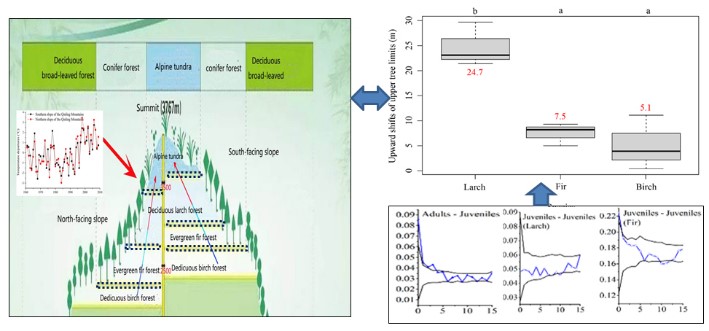Name:Haishan Dang
Tell:
Email:dangkey@wbgcas.cn
Organization:Wuhan Botanic Garden
How Temperature Warming and Biotic Interactions Jointly Affect Elevational Shifts of Upper Species Limits?
2020-04-22
Examinations of upper elevational distribution limits of tree species can provide indications of how subalpine vegetation responds to the ongoing climate warming. The upper elevational distribution limits of subalpine forest act as the cold temperature range margin. Tree recruitment and growth within treeline ecotone are generally low-temperature-limited, and thus warming may cause the upward movement of treeline and the increase in tree density. Indeed, the ongoing temperature warming has force extensive upward shift of treelines followed by the increases in tree density during the past century. However, dynamics and functional mechanisms of tree species-specific upper elevational limits below treeline remain unclear.
In order to understand the dynamics and functional mechanisms of non-treeline tree species, the Forest Ecology Group led by Prof. DANG Haishan of Wuhan Botanical Garden used a state-of-the art dendroecological approach to reconstruct long-term changes of species-specific upper elevational distribution limits of different plant functional types along elevational gradients in the Qinling Mountains of north-central China.
This study demonstrated that across three different tree species, upward movement of upper elevational distribution limits driven by temperature warming were different, showing the maximum upward shift of larch with an average elevation of 24.7 m during the past century, while only a slight advance of the non-treeline tree species. Meanwhile, the point pattern analyses showed that non-treeline tree species had experienced intermediate interspecific competition while the treeline tree species experienced no interspecific competition. Therefore, the disparity in elevational advance of upper species limits might be attributable to the presence of interspecific competition.
This work not only enhanced mechanistic understanding of long-term species-specific upper elevational distribution limit changes, but also highlighted the jointly effects of rising temperatures and species interactions on subalpine vegetation dynamics.
This work was supported by the Biodiversity Survey and Assessment Project of the Ministry of Ecology and Environment of China, the National Natural Science Foundation of China. Relevant research results have been published in Science of the Total Environment entitled “Disparity in elevational shifts of upper species limits in response to recent climate warming in the Qinling Mountains, North-central China”.

Species-specific upper elevational distribution limits of different plant functional type showed substantial disparity in elevational shifts as a response to recent climate warming, which might probably be attributable to the differences of interspecific competition (Image by SHI Hang)